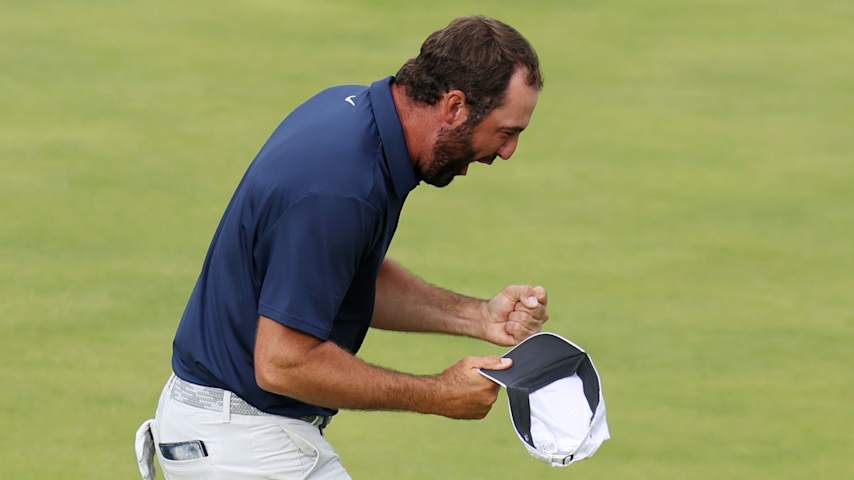British Open 2025: At Royal Portrush, distance is secondary
8 Min Read

Round 2 highlights from The Open
Written by Paul Hodowanic
PORTRUSH, Northern Ireland – Royal Portrush’s first hole looks rather innocuous, a straightaway 420-yard par-4 slightly up the hill. Two bunkers dot either side of the fairway – one 270 yards away and another 290 yards out. The landing area narrows around 330 yards, but with a strong wind into the players and off the right, there’s space for the whole field to pull the driver, if they want.
So why has Rory McIlroy hit a driving iron in the first two rounds of The Open Championship, Scottie Scheffler opted for a fairway wood and the likes of Cameron Smith and Max Greyserman were unable to even reach the fairway?
The answer is the reason why Royal Portrush has proven so compelling through two days. This is a distinct Irish links test, different than other courses in the Open rota and miles different from the traditional golf played on the PGA TOUR week in and week out.
On the first, internal out-of-bounds lines on both sides – an unused strategy on most courses. Get anything turning over with the wind, and it might careen through the left rough. Try and start it well right only for the wind to briefly die down? It’s gone. Suddenly, you’re re-teeing on your first hole of the day.
“You’ve got to thread it,” Jason Day said Thursday.
Elsewhere, massive dunes force unrealistic carry distances or narrow doglegs threaten the possibility of running it through the fairways. Pot bunkers are placed strategically throughout, forcing players to be uncomfortable with whatever shot they choose to hit. Oh, and a consistent crosswind that hasn’t relented over two days at Portrush is ever-present, pulling and pushing shots into unsavory spots.
All that has rendered distance secondary in The Open Championship test, a component of the puzzle but far from the overwhelming priority that it often becomes at the other three major championships and the rest of the TOUR calendar.
Just look at the top of the leaderboard for proof.
Brian Harman, far from anyone’s idea of a bomber, plotted his way around Royal Portrush beautifully, shooting a bogey-free 65 to jump into the early lead. He’s averaged 285 yards per drive, 10 yards fewer than the field average. The Open winner at Hoylake in 2023, Harman’s golf is particularly suffocating when rolling and given the room to work. He hits it low, rarely off line and relies on a tidy approach game to consistently give him midrange birdie chances. Make a few of them and suddenly a round like Friday is possible, and looks sustainable.
“It's not so much of an aerial attack," Harman explained. “There's probably 10 different types of clubs, irons, drivers, woods that you can hit off the tee. There's different ways to attack into the green, and there's almost always a hill that will kind of kill a shot coming into the green.”
This is the style of golf Harman thrives in, and the one Portrush emphasizes. It’s a thoughtful test, though it doesn’t prescribe one way to play. At 7,381 yards, Royal Portrush is middle of the road when it comes to distance, but bombing it over isn’t the strategy de jour. There’s too much to risk by doing it.
Need an example? Let’s go back to the first hole.
Ben Griffin, playing in his first Open, hit a towering drive Thursday that caught the wind and flew well out of bounds and nearly up against the 18th grandstand. Jacob Skov Olesen, one of the 18-hole co-leaders, blew his out of bounds right to begin his second round, then sent his second drive out of bounds in the other direction, ultimately making a quadruple bogey. Players are used to bunkers and thick rough back in the States. But internal OB strikes the fear of God in them.

Jacob Skov Olesen begins day with costly quadruple bogey at The Open
Then you reach the second hole, a brawny 575-yard par-5. That would surely be an automatic driver. McIlroy thought so Friday, but his shot started a little too far right and carried through the fairway and into thigh-high fescue that forced him to take an unplayable. Meanwhile, his playing partners, Tommy Fleetwood and Justin Thomas, neither of whom hit it as far as McIlroy, opted for a fairway wood. Fleetwood’s drive went 294 yards, and he hit the same fairway wood again 290 yards from there. Both Fleetwood and Thomas made birdie.
Royal Portrush is littered with these questions, unique in itself on the Open rota. Set along the Causeway Coast, Royal Portrush is fully Irish. It’s the only Open venue outside Great Britain, and it’s quite obvious in the rolling dunesland that it plays over and around.
The back nine begins with a pair of doglegs, not too dissimilar from one another. The 10th works back south down the property and hooks to the left, while the 11th heads back north and turns right, nearly meeting back up with the 10th tee box. Off the tee, neither presents clear landing areas. The aggressive line is over the dunes and the carries are manageable – anywhere from 260 to 310 yards – but take those on with driver and there’s a good chance it will land, catch a slope and get deposited into the rough on the far side. Lay back and it’s a simpler tee shot but a more complicated approach.
“I've just accepted that I could have a 5-iron in there,” Rasmus Højgaard said, who, despite having some of the most firepower in the field, has opted to keep driver in the bag on most tee shots. In fact, he’s hit only eight drivers in 29 opportunities, the fewest in the field. Yet he’s 5-under and inside the top-10.
“I've hit a lot of 2-irons and 3-woods,” Højgaard continued. “That's sort of been my game plan. There's certain holes where I see a different shot than probably some others do.”

Rasmus Højgaard pumps up crowd with closing birdie at The Open
But that doesn’t mean hitting driver often can’t be successful. Harry Hall has hit driver 22 times, most in the field, and he’s 2-under. Though the numbers tell a different story, Keegan Bradley held the opposite belief to Højgaard.
“The problem with laying way back is you're also going to have a 5- or 4-iron in, and find that to be really difficult, and then if you miss the fairway from there, you're in deep trouble. You really have to commit and then you've got to get some good bounces out here,” said Bradley.
On other holes, it’s not so much the contouring of the fairways or forced carries as it is the pot bunkers. Take the par-5. At 532 yards, it’s an incredibly gettable par-5 with or without driver. Yet there isn’t a club that will eliminate the bunkers altogether. One bunker is smartly positioned 292 yards out, reachable for almost everyone in the field from the elevated tee box. You could pull driver and try to take it out of play, except there’s another bunker lurking at 323 yards.
“I have a real appreciation for how well bunkered it is off the tee. It's like, okay, well, I can hit a 2-iron off the tee, but that brings this bunker into play,” McIlroy said earlier this week. “But then if I hit driver, it'll bring this bunker -- so you have to take on the shot. You have to say, okay, I'm going to commit to hitting this shot and I just know I'm going to have to avoid -- like some courses that we go to in the Open rota you can just take the bunkers out of play. You can lay up short of them or go beyond them. Here there's always one bunker or another bunker in play, so I think off the tee it provides a very, very good test.”
Add in the elements and the variables multiply. Rickie Fowler, not a long hitter by today’s standards, hit just a few drivers Friday and it wasn’t because of runouts or carries. It was the wind. The course plays into a prevailing crosswind, which the course has played with the first two days.
“I typically don't hit many drivers in left-to-right wind,” said Fowler, who played most of the back nine in that wind direction. “That's why I carry a mini (driver). I draw it a lot easier. I'm able to hold it better. I didn't do a great job of that today. But at least they were somewhat in play.”
Then there’s the rain, which has popped up throughout two days of play. That “adds a how new element to it,” Scottie Scheffler said, “especially when you're hitting the tee balls. You get a little moisture between the club face and the ball, especially with the longer clubs and the woods, and it can be pretty challenging.”
All that put together has created a refreshing test of golf at The Open. McIlroy, typically one of the world’s best drivers, hasn’t been able to find any confidence with off the tee. Yet his ball-striking and short game artistry has buoyed him at 3-under, with a chance heading into the weekend. Scheffler hit two fairways in the first round and shot 2-under. At the same time, those who are driving it well are still being rewarded. Robert MacIntyre ranks second in strokes gained and is tied fifth on the leaderboard at 5-under.
Golf is better with a diversity of styles littered on the leaderboard. The Open achieves it better than most. Royal Portrush might just be its crown jewel.






